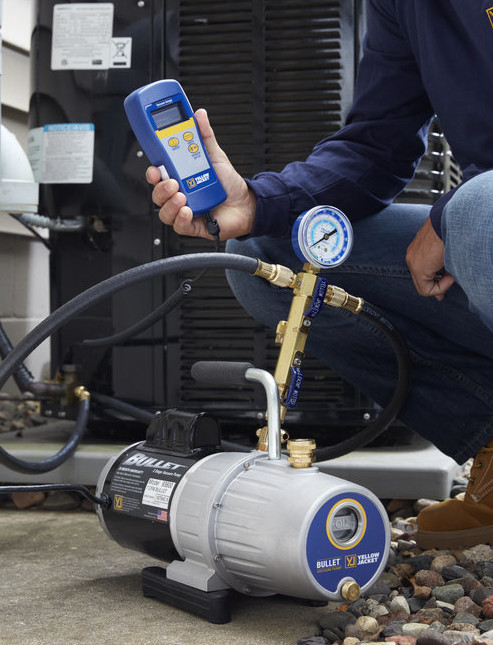Gear Up: Tools For A Fast and Efficient Evacuation
Nothing will make your evacuation job slower than getting to a job site and realizing that you have forgotten an essential piece of equipment.
The trick to getting the job done quickly and efficiently is to keep it simple.
Along with a reliable pump, there are a number of essential tools that will help you be more efficient in the evacuation process. Here are a couple of tips to keep in mind so that your next evacuation goes smoothly as possible
Hose size matters: When choosing a hose, select the largest diameter that you can, even if your system has quarter-inch fittings. If you’re using a YELLOW JACKET vacuum pump, select a 3/8” hose with quarter-inch fittings to attach to the pump. Since long hoses will slow the process, use the shortest hose possible to get maximum evacuation speed.
Another option is to use corrugated stainless steel hoses, which have no permeation. If you keep these clean and well maintained, they will offer the most effective evacuation possible, job after job and for years to come.
 Save time removing the valve and core: Vacuum valve and core removal tools allow you to remove Schrader valves from the system and evacuate through unrestricted lines for a faster and higher vacuum. If your system has both high- and low-side ports, use a vacuum valve and core removal tool for each port.
Save time removing the valve and core: Vacuum valve and core removal tools allow you to remove Schrader valves from the system and evacuate through unrestricted lines for a faster and higher vacuum. If your system has both high- and low-side ports, use a vacuum valve and core removal tool for each port.
Use an evacuation manifold: When you use an evacuation manifold you create a connection point for two larger diameter hoses right at the vacuum pump. This allows you to maximize the hose diameter, minimize the hose length, and minimize the number of fittings and potential leak points – giving you the fastest evacuation.
Go electric: There is no way to know when you have pulled an adequate vacuum without an electronic vacuum gauge. The American Society of Heating, Refrigerating, and Air-Conditioning Engineers (ASHRAE) recommends evacuation to below 1000 microns, and after isolation, a system must not rise above 2500 microns within several hours.
1000 microns equal only .039 inches of mercury, a measurement that cannot be made with a mechanical gauge or determined by evacuation time or the sound of the pump. The only tool that can measure vacuum at these levels is an electronic vacuum gauge.
With an electronic vacuum gauge, you can see the last evidence of moisture being removed and witness that the system has dried out.
For a step-by-step overview of the evacuation process, be sure to watch out video here.
